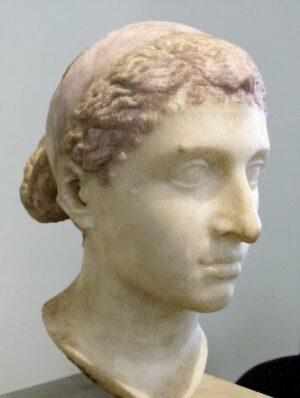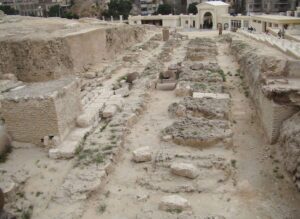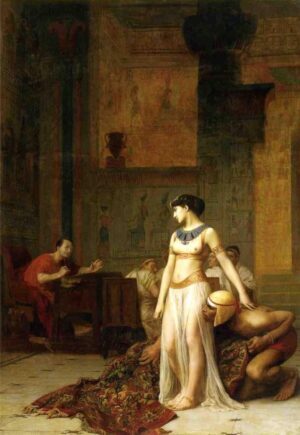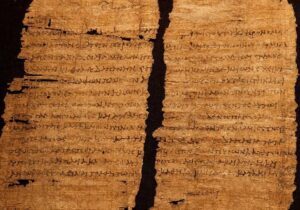
Editor’s Note: The drama and human interest that surrounds the story of Cleopatra in history continues to fascinate story-tellers as well as scholars to this day. Whatever one’s perspective and opinion, her legacy in her corner of the world endures as a testament to her power and influence during the early years of the rise of the Roman Empire……….
____________________________
RM (Richard Marranca): Queen Cleopatra with Adele James on Netflix is a big event. And Cleopatra (1963) with Elizabeth Taylor and Richard Burton is one of the most expensive films ever made. Both (and much else in the Cleopatra industry) keep Cleopatra’s story going, don’t they?
PC (Paul Cartledge): Streaming movies is now the mass-est of mass media receptions, far bigger ‘box office’ than actual box office at movie theaters. In its day, Joseph Mankiewicz’s Cleopatra was the hottest ticket in town: https://www.imdb.com/title/tt0056937/. But not only and not most for the quality of the filmmaking (overblown, overdone, overhyped) but rather for the sexual shenanigans going on between its two main stars both on and more especially off set. But there are other media whereby Cleopatra’s name and supposed career are continually – almost continuously – brought before the eyes of the public to gawp and wonder at: books (some quite serious contributions to scholarship, such as M. Miles Cleopatra: A Sphinx Revisited, 2011, others not), exhibitions (a good one at London’s British Museum, 2001), and of course the perennially popular Shakespeare history/tragedy. Whether it’s right to speak of a ‘Cleopatra industry’ is not so certain, at least not in the sense of a centrally organized production line created by an official fan club. There are – and always have been – more than one Cleopatra – see the next answer.
RM: Harold Bloom (the late literary scholar) has called Cleopatra “the world’s first celebrity.” Wherever she lands in the lineup, he wasn’t kidding. Is she a celebrity?
PC: I would strongly disagree that she was the world’s ‘first’ celebrity – that questionably honorific title surely should go to Helen of Sparta and Troy, thanks to Homer and Euripides – and the initially European Renaissance! A good friend and ancient historian colleague of mine, Robert Garland, wrote a brilliant book on Celebrity in Antiquity (2006) – spoiler alert: I commissioned it for a series I then co-edited with Susanna Morton Braund. There is no question but that Cleo was and is a celebrity, that is, she fulfills both the ancient and the modern criteria for this dubiously honorific label.

The Berlin Cleopatra, a Roman sculpture of Cleopatra VII wearing a royal diadem, mid-1st century BC (around the time of her visits to Rome in 46–44 BC), discovered in an Italian villa along the Via Appia. Altes Museum, Berlin, Germany. Public Domain, Wikimedia Commons
As to ancient Graeco-Roman criteria, what mattered is that she was in intimate relations with two of the most powerful men in the then known Mediterranean world. As Clytemnestra was to Agamemnon or Aspasia to Pericles, so was Cleopatra to Julius Caesar and Mark Antony – besides being a queen regnant in her own independent right. As far as modernity is concerned, I prefer to see Cleo as a ‘tabloid queen’, as she was treated in the final chapter of Garland’s book, fulfilling the book’s subtitle ‘From Media Tarts to Tabloid Queens’. ‘Tabloid’ has implications of cheapness, of mere celebrity, of being famous for being famous, which is the trend unhappily set for her by the flop movie of 1963 (that discouraged filmmakers and movie moneymen from treating the ancient world for a generation – until Gladiator in 2000). In the historical actuality of the later first century BCE, she was much much more important than that.
RM: In our recent interview, you mentioned that Ptolemy I hijacked Alexander’s corpse and brought it to Egypt. Can you tell us about the genius, power, and peculiarities of the Ptolemies?
PC: *These are two different types of question, although they do overlap. Different because the Ptolemies had to present quite different faces to the native Egyptians and especially the powerful priesthood, on the one hand, and to the Graeco-Macedonians and other peoples, such as the Jews, of Alexandria, on the other. To illustrate the former, there is no better example than what has come to be known as the ‘Rosetta Stone’, now housed in London’s British Museum: a trophy of war (Napoleonic, 1801), it was then ‘greenwashed’ to become the basis of the decipherment (by French scholar Champollion following British scholar Young) of Egyptian hieroglyphs: see e.g. John Ray The Rosetta Stone and the rebirth of Ancient Egypt (Profile Books, London, 2007). The Stone bears three texts, which are supposed to be close copies of each other: one in hieroglyphics, another in Egyptian demotic (cursive script, the language a precursor of Coptic), and the third in (Hellenistic koinê) Greek. It records an agreement struck in 196 BCE between Ptolemy V and the Egyptian priesthood. Several copies were made and exhibited in various Egyptian temples, but only the Rosetta version survives in something approaching completeness.
For Alexandrians, however, mainly of course Greek Alexandrians, the Ptolemy dynasty had to put on a show that would justify their appropriation of the titles ‘King’ and ‘Queen’ and the claim that those titles implied to be the legitimate successors ultimately to the Egyptian pharaohs and more proximately to the kings of Macedon and of (Achaemenid dynasty) Persia. Hence the royal palace – now forever lost, submerged in the Mediterranean; hence the royal tombs (likewise lost, like that of the City Founder, Alexander); and hence the Pharos lighthouse, a bigger and better iteration than anything remotely comparable anywhere else in the known world – functional for trade but also a grandiloquent propaganda statement. It was by no means predictable, however, that one of the ways of promoting themselves both in Greek Egypt and to the wider Hellenic world would be through the promotion of high intellectual culture. It was probably Ptolemy II rather than his father Ptolemy I (died 284 BCE) who actually oversaw the building of the famous Museum (in Greek Mouseion, meaning a religious shrine devoted to the worship of the Nine Muses) with its attached Library. The complex became a beacon of scholarship, even if the scholars attracted to work there including the likes of Callimachus (an early Librarian) and Archimedes did not always do so harmoniously. My own pick of a very distinguished bunch is Eratosthenes, who hailed from the Greek city of Cyrene in eastern Libya along the coast from Egypt. He was nicknamed Beta (‘Second’) because, although he was of alpha quality across many intellectual fields, he was never accounted top dog in any one – being outshone in math, for example, by Archimedes (from Syracuse in Sicily). Perhaps his greatest intellectual achievement was to calculate the circumference of planet Earth with a very acceptably small margin of error.
RM: And what a city, Alexandria – lighthouse, library, vast multicultural population!
PC: You mentioned Alexandria’s vast, multicultural population. It’s been estimated that by the time of Cleopatra – and Augustus – Alexandria may have become the world’s first million-inhabitant city. Of the many cultures represented within the huge population, that of the (diaspora) Jews is one of the most interesting and significant, for two reasons, one good, one very bad indeed. The bad one is that Alexandria witnessed the first very serious outbreaks of antisemitism, or, as some prefer, Judeophobia. Jews were monotheists, not polytheists, and their peculiar customs included circumcision, which Greeks found aesthetically abhorrent. Prejudice and murderous violence ensued. The good reason, at any rate if one is any kind of Christian today, is that it was in Alexandria in the 3rd century BCE, for Jews who had lost familiarity with their ancestral Hebrew language, that the Hebrew Bible was translated into Greek, becoming known thereby as the Septuagint. Thus when (St) Paul and his fellow-Jewish (by birth and upbringing) proto-Christians needed an authorizing textual precedent for their utterly untraditional and newfangled scriptures written in koinê Greek (eventually the New Testament), they could call upon the Septuagint, an oven-ready holy textbook.
_____________________________

The remains of the ancient site of the Temple complex of Sarapis at Alexandria. It once included the temple, a library, lecture rooms, and smaller shrines but after many reconstructions and conflict over the site it is mostly ground level ruins. Institute for the Study of the Ancient World. Creative Commons Attribution 2.0 Generic, Wikimedia Commons
_____________________________
RM: Cleopatra is the last of the Ptolemies. Can you tell us about them? And why were they so murderous with each other? Maybe intermarriage was a bad idea…
PC: They were indeed often murderous: Cleopatra herself is a good – or rather a very bad – example. But they weren’t always. The second Ptolemy married and reigned conjointly with Arsinoe I for over 35 years, apparently harmoniously. This was a classic dynastic marriage, uniting the Ptolemaic house with that of Lysimachus, Arsinoe’s father, who had established himself as an independent post-Alexander Hellenistic ruler in the region of Thrace (modern Bulgaria and part of north Aegean Greece). But when Ptolemy IV married Arsinoe III, he was marrying his full sister, in a brother-sister marriage of the type Cleopatra was herself to practice (if hardly with enthusiasm or kindness). Why did the Ptolemies feel they could cheerfully break the normal Greek incest taboo, or, put it another way, why did they feel that such a marriage would be an asset to their rule rather than a liability? Those questions have plagued modern scholarship, and are well discussed here by Sheila Ager: https://uwlabyrinth.uwaterloo.ca/labyrinth_archives/all_in_the_family.pdf. I have no new suggestions to offer. The obvious points to note are that such marriages avoided possible complications (disputed inheritance, interfamilial and possibly interstate hostility) of exogamy, or out-marriage, and that they overtly reinforced the strongly dynastic, blood-based character of the royal regime.
RM: I think that for many or most people who learned this stuff, the focus was on Julius Caesar getting stabbed to death because he was getting too big – a dictator, maybe a god. Scary for some of the elite. But Julius was killed while Cleopatra was in Rome. The plot thickens…
PC: Certainly a couple of years later, in 46 BCE, by which time Pompey was dead (killed in Egypt) and Caesar was firmly in position as dictatorial sole ruler of the Roman world, Cleopatra came to consort adulterously with Caesar in Rome in full if controversial public view.

Cleopatra Before Caesar by Jean-Léon Gérôme, oil on canvas, 1866. Public Domain, Wikimedia Commons
A 17-year-old C. Octavius duly noted Cleopatra’s unpopularity with the Roman public – and took full propaganda advantage as he too engaged in civil war, in the 30s, against a Mark Antony by then bigamously married to Cleopatra, father of three children with her, and acting out the full-on role of an oriental Hellenistic potentate. Octavius noted also the unpopularity of Caesar’s all too blatant moves, aided by Antony, to get himself equated in Rome to a Hellenistic regal monarch, a king, the most un-Republican thing in the world. Hellenistic kings and queens, such as Cleopatra, were routinely given divine worship as living gods, but for Caesar to be accorded divine status, as he may well have desired, would have breached another Roman Republican taboo. Brutus and Cassius, leaders of the Republican resistance, therefore had plenty of ideological as well as physical ammunition to do what they did in the Senate House on the Ides of March 44 BCE.
RM: Cleopatra outsmarted Antony in a few ways. She had to. But was she interested in becoming the next Alexander the Great or leader of the Roman empire? Was her son Caesarion intended for that role? It is epic soap opera with extremely high stakes.
PC: Among her many and varied accomplishments, Cleopatra was said to be the first of the Ptolemies to learn the native Egyptian language, presumably so as to be able to speak it as well as read it. That tells me that her first and overriding aim was to preserve the Ptolemaic kingdom and dynasty, and to preserve herself as the incumbent Ptolemy. Rome, unfortunately, could not be ignored and had to be bought or bedded off.
Antony, when the final showdown with Octavian came in the late 30s, had the support of almost all (Sparta was a notable exception) the eastern, Greek-speaking half of the Roman world, whereas Octavian could count on the forces and resources of Italy and the Roman ‘West’. Antony – with Cleopatra – should have fared better than he did in the final naval battle of his civil war, at Actium in 30 BCE. But he was up against a remarkably determined, ambitious and cunning, if unmilitary, opponent in Octavian, who could count on the support of one of the most brilliant figures of his age, Marcus Vipsanius Agrippa. Agrippa commanded the victorious fleet at Actium off northwest Greece, for which he was rewarded successively with elevation to near-parity of status and power with Augustus (as the first Roman emperor became in 27 BCE) and marriage to Augustus’s eldest daughter Julia (as all women of the Julian patriline were named).
RM: What do archaeology and science tell us about Cleopatra—is her tomb gone forever?
PC: As noted in passing above, yes, her tomb is, like my darling Clementine of the song, lost and gone forever. Archaeology, the study of material culture and mute material remains, tells us relatively little about her that we would not have gleaned from the extant written sources, including a papyrus dubiously claimed to be autograph, or that we would not have surmised from comparative archaeological evidence for works commissioned by earlier Ptolemies or for her rival Hellenistic royal contemporaries and predecessors – in the Near or Middle East.
RM: What did we miss? Any last words?
PC: Rest In Peace?!
______________________________

In February 33 B.C., Cleopatra approved an order granting certain tax exemptions to Publius Canidius Crassus, who had been with Antonius for a decade and would be senior commander of the land forces at Actium. The relevant document is a papyrus (shown above) recovered from mummy wrappings and first published in the year 2000. Canidius was allowed to import 10,000 artabas of wheat and 5,000 amphoras of wine tax free, and the lands that he owned in Egypt were also exempt. What has excited interest is the subscript in a different hand: γινέσθωι (“make it happen” — last short line, faint, lower right). There is little doubt that this is the writing of the queen herself, as there was a tradition in Ptolemaic Egypt of countersigning by the monarch, in part to avoid forgery of official documents. This autograph of Cleopatra VII certainly is one of the more exciting discoveries of recent years: the only other known royal autographs from antiquity are of Ptolemy X and Theodosios II, both somewhat less interesting than the queen. The document also indicates the dichotomy that still existed at the very end of the Ptolemaic era between the rulers (and their Roman allies) and the ruled, where the former continued to obtain special privileges. Roller, Duane W. (2010) Cleopatra: a biography[1], Oxford: Oxford University Press. Public domain, Wikimedia Commons
Cover Image, Top Left: Pixabay image.


